Abstract
Flood models based on high-resolution digital elevation models (DEMs) are important for identifying urban land inundation during extreme rainfall events. Urban pluvial and fluvial floods are influenced by distinct processes that are interconnected; thus, they can transform into one another. Conventional flood models struggle to delineate inundation caused by drainage system overflow (urban pluvial flood) and that caused by rivers (urban fluvial flood). In this study, we proposed a novel method for identifying urban pluvial–fluvial floods using a high-resolution DEM. We developed a DEM-based surface pluvial and fluvial inundation tracking model (DEM-SPFITM) that incorporated flood development and mutual transformation processes. When combined with a surface flood control model (SFCM), this approach enabled tracking of the flow paths and exchanged water volume associated with both flood types. The case study results indicate that the proposed method effectively captures the interplay between pluvial and fluvial flooding, enabling the separate identification of flood extent, depth, and velocity under extreme rainfall conditions for both pluvial and fluvial flooding. Compared to the conventional approach, which independently simulates pluvial and fluvial flooding using the SFCM and subsequently overlays the results to estimate pluvial–fluvial flooding inundation, the proposed method demonstrates superior accuracy and computational efficiency. Simulations of three extreme rainstorms indicated that pluvial flooding primarily contributed to extensive land inundation, characterised by shallower depths and lower velocities, with a limited influence of flood depth on velocity. Meanwhile, fluvial flooding further exacerbated land inundation, leading to significant pluvial–fluvial coexistence. In areas adjacent to these flood zones, fluvial flooding predominated, resulting in greater inundation depths and a more pronounced effect of flood depth on velocity. As rainfall intensity and total rainfall increased, the area of fluvial inundation diminished significantly, whereas pluvial–fluvial coexistence intensified and was distributed in zones with relatively large inundation depths and higher flow velocities. This research presented a novel method for distinguishing between urban pluvial–fluvial floods, providing valuable insights for integrated urban flood management and joint flood risk zoning.
1. Introduction
Flooding is among the most common and destructive natural disasters in urban areas [1,2]. Owing to climate change and rapid urbanisation [3], cities with limited river networks face a lower risk of fluvial flooding [4]. However, in cities with extensive and complex drainage systems (encompassing both drainage pipelines and river networks), combined urban pluvial and fluvial flooding has become increasingly severe, posing serious threats to public safety, urban functioning, and development [5,6,7]. For example, during the 2021 “7.20” heavy rainfall event in Zhengzhou, Henan Province, China [8], the Jialu, Qili, and Jinshui Rivers experienced high water levels. Surface runoff was not discharged into these rivers through drainage pipelines, and some river sections overflowed. The surface flow originated from upstream inflows and local rainfall, which interacted and exhibited typical characteristics of combined pluvial and fluvial flooding. The generation and mutual transformation of pluvial and fluvial floods represent a complex process, making it particularly difficult for authorities to coordinate urban flood management [9]. Pluvial flooding occurs when the drainage system’s capacity is insufficient during heavy rainfall, causing excess rainwater to overflow and flow across the land surface. Fluvial flooding, on the other hand, occurs when the water levels in river networks continue to rise, resulting in overflow that spreads across the land surface. Under extreme rainstorms, the inundation depth and flow velocity of pluvial flooding induced by manhole overflow in drainage networks is generally smaller; however, it can extend over extensive areas within the river network. When combined with river overflow-induced fluvial flooding, pluvial flooding can considerably exacerbate the overall flood disaster [7]. Furthermore, urban fluvial flooding occurs much less frequently than pluvial flooding but typically presents greater inundation depths and flow velocities, posing severe threats to public safety and infrastructure [10]. Consequently, distinguishing the inundation extent, depth, and velocity of combined pluvial and fluvial flooding under extreme rainfall and analysing their interrelationships are of practical significance.
Flood models are crucial for identifying urban surface inundation under extreme rainfall. These models encompass data-driven approaches that rely on observations and physical-based approaches that emphasise hydrological and hydrodynamic processes. The former can over-rely on observational data, for example, the use of statistical methods to study urban flooding, the use of multiple regression analyses to assess regional flood risk, and the combination of hierarchical analyses and geographic information systems to analyse regional flood hazards, which are often difficult to interpret physically, which may present risks in practical applications [11]. In contrast, physical-based approaches are rooted in hydrology and hydraulics and are generally considered more robust and accurate [12,13,14]. A physical-based flood model typically encompasses surface runoff, drainage network flow, river network flow, overland flow, and interactions among these processes, thus requiring abundant data and significant computational resources. Hydrological methods for surface runoff are efficient and straightforward. One-dimensional hydrodynamic approaches for drainage and river network flows require minimal data and offer high computational efficiency. Two-dimensional overland flow is often calculated using shallow water equations (i.e., depth-averaged Navier–Stokes equations), which can be solved using finite-difference or finite-volume methods [15,16,17], albeit with high computational complexity. For large inundation areas, ensuring high-resolution grids drastically reduces computational efficiency. Employing a shallow water approach with inertial terms (or their simple approximations) through orthogonal storage cell methods for overland flow can yield reliable results [18]. This approach permits a larger and more stable time step, achieves high computational efficiency, remains unaffected by grid resolution, is sensitive to surface friction, and is readily scalable and programmable. Regardless of the adopted method, constructing a flood model requires the careful consideration of several factors that influence flooding to ensure model accuracy [19].
Although pluvial and fluvial flooding originate from different causes and have distinct impacts, they are interrelated and can transition between one another [9]. For example, during extreme rainfall, pluvial floods originating from manhole overflow may flow through the drainage network or directly into rivers, subsequently re-entering low-lying areas or downstream sections of the river network through overflow and causing urban fluvial flooding that aggravates inundation [6]. Conversely, fluvial flooding can propagate from overflowing river cross-sections into the drainage network, further reducing drainage capacity. The overflow at downstream or low-lying manholes then leads to pluvial flooding on the surface, exacerbating flood hazards [6]. Although some studies consider the influence of both pluvial and fluvial processes on urban flooding, few have specifically examined their mutual transformation and the resulting impact on overland inundation. Most urban flood research lacks in-depth joint analysis of pluvial and fluvial flooding, relying solely on flood model simulations under extreme rainfall and typically using inundation extent, depth, and velocity to quantify flood impacts [20]. This could be due to limitations in data availability and the constraints of existing flood models. When cities face combined impacts of pluvial and fluvial flooding, more detailed indicators (e.g., pluvial flood depth, fluvial flood depth) may be needed, requiring a flood model that simultaneously and separately computes pluvial and fluvial flood depths. Thus far, nearly all urban flood modelling studies have failed to track the flow processes and exchanged volumes of pluvial and fluvial floods simultaneously and separately within a single model. Most have only treated the total inundation caused by various sources—pluvial floods, river floods, coastal storm surges, extreme rainfall, storm tides, and occasionally groundwater surges or dam breach floods—to assess multi-hazard flood risk [21,22]. Forward-looking approaches may simulate pluvial and fluvial floods separately and superimpose the results. However, such methods overlook the flow interactions between pluvial and fluvial floods and cannot track their flow paths or quantify the exchanged water volume collectively.
Therefore, this study aimed to achieve three objectives: (1) Propose a Pluvial–Fluvial Inundation Identification (PFII) method based on a high-resolution DEM; PFII comprises two main components: (a) a surface flood control model (SFCM) that simulates surface runoff, one-dimensional (1D) drainage network flow, 1D river network flow, two-dimensional (2D) overland flow, and their interactions; and (b) a DEM-based surface pluvial and fluvial inundation tracking model (DEM-SPFITM), which uses outputs from the SFCM to track the flow paths and exchanged volumes of pluvial and fluvial floods. (2) Apply PFII to the urban district of Huai’an, Huai’an City, where a complete flood process was observed, to identify the inundation extent, depth, and velocity caused by combined pluvial and fluvial flood under extreme rainstorms. (3) Quantitatively analyse how surface inundation extent, depth, and velocity respond to the combined effects of pluvial and fluvial floods.
2. Methods
2.1. Pluvial—Fluvial Inundation Identification Method
PFII involved three stages: building and running the SFCM, tracking the inundation extent and depth composition of floods, and calculating the flow velocity under flood conditions. Figure 1 illustrates the overall workflow, whereas Figure 2 presents a schematic overview of pluvial and fluvial flood sources.
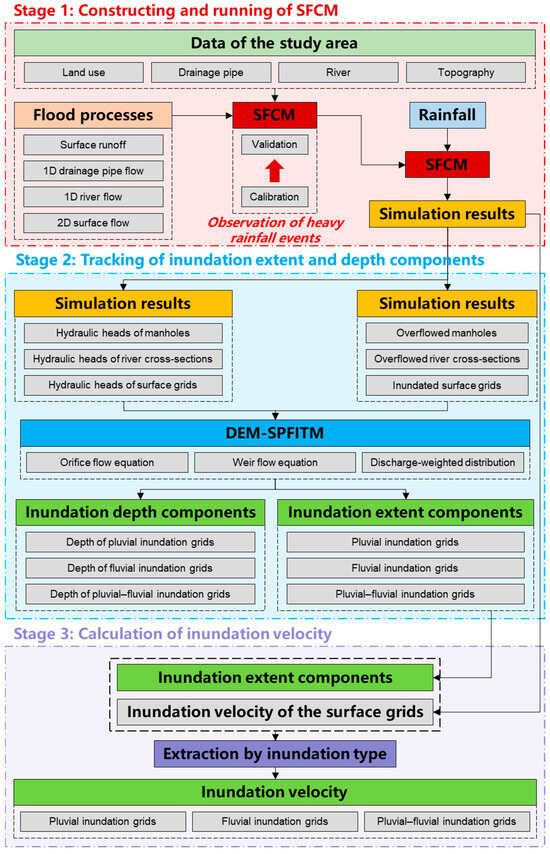
Figure 1.
Workflow of the PFII method.
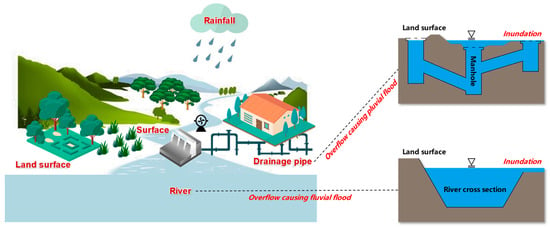
Figure 2.
Schematic of primary inundation water sources.
Stage 1: SFCM construction and operation. First, the model structure was determined, encompassing surface runoff, 1D stormwater pipe flow, 1D river flow, and 2D overland flow. Second, the land use, drainage networks, river systems, and terrain data for the study region were collected and processed. Subsequently, the SFCM was constructed and validated using observed rainfall events. The validated model was then driven by rainfall inputs to produce simulation outputs, comprising overflow and water head information at stormwater manholes, river cross-sections, and inundated overland grids.
Stage 2: Flood extent tracking. First, overflowing manhole, overflowing river cross-section, and inundated overland grid results from Stage 1 were obtained. Next, the DEM-SPFITM was constructed, and these simulation outputs were input into the DEM-SPFITM to trace pluvial and fluvial water flow paths and determine the inundation status of overland grids. Finally, the inundation extent was calculated and output specifically for distinguishing pluvial, fluvial, and pluvial–fluvial flood areas.
Stage 2 (continued): Composition of inundation depth tracking. Hydraulic heads of manholes, river cross-sections, and overland grids from Stage 1 were obtained and incorporated into the DEM-SPFITM. By considering flow allocation coefficients and applying weir/orifice equations, the exchange flux between pluvial and fluvial water was tracked, leading to the calculation of inundation depth in each grid. The resulting inundation depth composition was then determined and output separately for pluvial, fluvial, and pluvial–fluvial flood areas.
Stage 3: Flood velocity calculation. Overland flow velocities from Stage 1 and inundation extent from Stage 2 were extracted to classify the flow velocity by flood source, including pluvial, fluvial, and pluvial–fluvial flooding.
2.2. Surface Flood Control Model
The SFCM coupled the Storm Water Management Model (SWMM) and an orthogonal storage cell model to simultaneously simulate surface runoff, 1D flows in stormwater pipes and rivers, and 2D overland flow, thereby representing the complete physical flood processes in urban areas.
The study region was subdivided into arbitrary irregular subcatchments, and the surface runoff of each subcatchment was computed using a non-linear reservoir model [23]. The depth and inflow rate in a subcatchment was calculated using mass conservation:
where d is the subcatchment water depth (mm), t is time (h), i is rainfall intensity (mm/h), e is evaporation (mm/h), f is infiltration (mm/h), and q is runoff (mm/h).
Rainfall was expressed by its time-varying intensity. For relatively small study areas, rainfall was assumed to be spatially uniform, whereas for large areas, its spatial distribution was incorporated. Initial abstractions due to interception and evapotranspiration were simplified depending on the urban or catchment scale. Infiltration, the greatest contributor to rainfall loss, was calculated using the Horton equation:
where ft is infiltration rate at time t (mm/h), fc is the steady infiltration rate (mm/h), f0 is the initial infiltration rate (mm/h), k is the decay constant (h−1), and t is time (h).
In the presence of water exchanges between stormwater pipes and rivers, the 1D dynamic wave method [24] was used to model flows in stormwater pipes and rivers. The governing equations are:
where x is the distance (m), t is time (s), A is cross-sectional area (m2), Q is discharge (m3/s), H is hydraulic head (m), Sf is friction slope (m/m), and g is gravitational acceleration (m/s2).
The SWMM supports pumps and regulators. Pump performance was determined using four types of pump curves; regulators included orifices, weirs, and outlets, each with distinct relationships between geometry, discharge, and hydraulic head.
The orthogonal storage cell model [18] was used to solve the continuity equation for 2D overland flow:
where Δh denotes the water depth change in a cell (m), ΔQ is the flow variation (m3/s), Δt is the time step (s), and Δx and Δy are cell dimensions (m).
Overland flow in four directions was considered, and the unit-width discharge between adjacent cells was computed using shallow water equations with simple inertia terms [18]:
where q denotes the unit-width flow (m2/s), t is time (s), hflow is flow depth (m), Ssurf is water surface slope (m/m), n is the Manning coefficient, and g is gravitational acceleration. Each storage cell computes infiltration via the Horton model.
The SFCM was used to compute the water exchange among various processes by linking manholes, river cross-sections, and surface grids, and adopting a unified time step and data exchange scheme [25,26]. Figure 3 summarises the structure of the SFCM.
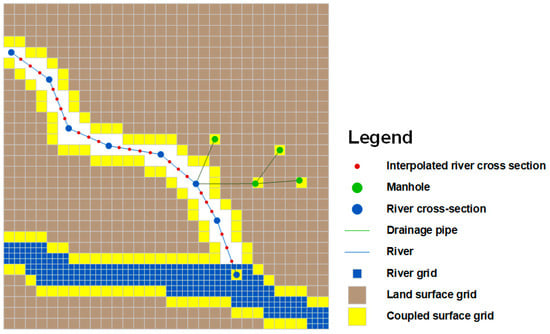
Figure 3.
SFCM structure.
2.3. DEM-Based Surface Pluvial and Fluvial Inundation Tracking Model
2.3.1. Fundamental Principles
DEM-SPFITM retrieved SFCM outputs at each time step by tracing the flow paths and exchanged water volumes of pluvial and fluvial floods within each grid cell to derive inundation status (flood type) and depth (pluvial and fluvial components).
where G represents the set of all surface grids, ghole indicates a grid connected to a manhole, gsection is a grid connected to a river cross-section, and gnull is a grid with no direct connection. Neighbouring grids in the up, down, left, and right directions are denoted by gup, gdown, gleft, and gright, respectively.
The inundation status set S classified each grid as 0 (dry), 1 (pluvial flood only), 2 (fluvial flood only), or 3 (both pluvial and fluvial).
The inundation depth set D included dpluvial (pluvial flood depth) and dfluvial (pluvial flood depth).
Water exchange to a grid ghole originated from a connected manhole or the surrounding grids, gsection received flow from a river cross-section or nearby grids, and gnull received flow only from neighbouring grids. Flow rates were computed using weir/orifice formulas and the inertial form of shallow water equations. For example, overflow from a manhole to grid ghole was calculated as:
where is the discharge of the manhole overflow to ghole (m3/s); Ahole and Chole are the area and circumference of the manhole (m2 and m), respectively; Hhole and are the hydraulic heads of the manhole and ghole (m), respectively; is the elevation of ghole (m); co and cw are the orifice and weir discharge coefficients, respectively; and g is the gravitational acceleration (m/s2).
Similarly, the overflow from a river cross-section to grid gsection was calculated as:
where is the discharge of the river cross-section overflow to gsection (m3/s); Lsection is the distance to the adjacent river cross-section (m); Hsection and represent the hydraulic head of the river cross-section and gsection (m), respectively; and is the elevation of gsection (m).
According to Equation (6), the overflow discharge from the four adjacent grids to ghole, gsection, and gnull were as follows:
where are the discharges of overflow from the four adjacent grids to ghole, gsection, and gnull (m3/s); are the discharges per unit width between ghole, gsection, and gnull and the four adjacent grids (m2/s); and are the connection widths between ghole, gsection, and gnull and the four adjacent grids (m).
2.3.2. Calculating the Set of Grid Inundation States
At each time step, the grid inundation status set S (in which cells are dry, pluvial-only, fluvial-only, or pluvial–fluvial) was updated. The flow chart for time t is shown in Figure 4.
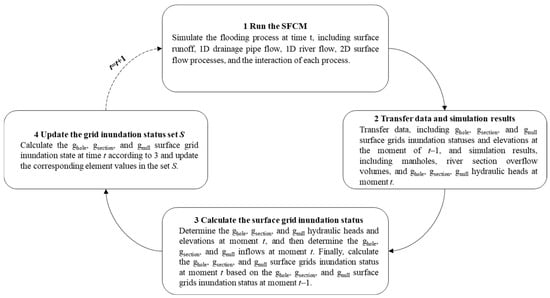
Figure 4.
Flowchart for computing the grid inundation status set S at time t.
In step 3, the inundation status of each grid cell was calculated according to different hydraulic connections. For example, for a manhole-connected cell ghole, the status was determined based on the inundation status at the previous time step (t − 1) and the inflow at time t. Similarly, the inundation status of gsection and gnull was obtained using Equations (10)–(15).
Taking ghole as an example:
Condition 1:
Condition 2:
Or
where g′ denotes the four adjacent grids, whose overflow enters ghole.
Condition 3:
Or
2.3.3. Calculation of the Grid Inundation Depth Set
At each time step, DEM-SPFITM was used to calculate the inundation depth set D. Figure 5 shows the calculation flowchart at time t.
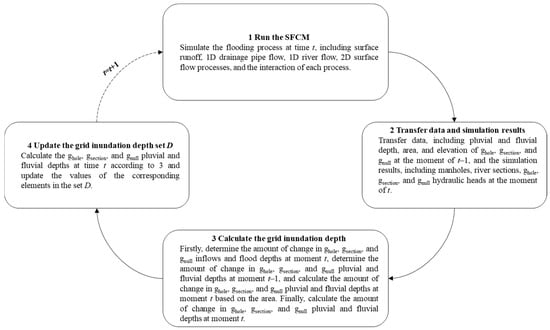
Figure 5.
Flowchart for computing the grid inundation depth set D at time t.
In step 3, the inundation depth for each grid cell was updated based on inflows and infiltration. For example, at a manhole-connected cell ghole, the pluvial depth increment at time t from manhole inflows was:
where is the area of ghole (m2).
Additionally, the depth variation in the pluvial floodwater originating from the grid above ghole at time t was expressed as follows:
Similarly, according to Equation (17), the depth variations in the pluvial floodwater originating from the grid below, on the left, and on the right of ghole at time t were obtained. The pluvial flooding depth of ghole at time t was expressed as follows:
Similarly, the fluvial flooding depth of ghole and the pluvial and fluvial flooding depths of gsection and gnull at time t were calculated using Equations (16)–(18).
3. Case Study
3.1. Study Area
Huai’an City is located in the lower reaches of the Huai River in northern Jiangsu Province, China. The region has an annual average rainfall exceeding 900 mm, 65% of which occurs between June and September, resulting in frequent flood disasters. The 23.92 km2 Huai’an District study area is located at the confluence of the Beijing–Hangzhou Grand Canal and the Subei Irrigation Main Canal. The terrain is high in the northwest and low in the southeast, featuring a dense network of rivers and lakes. The terrain significantly weakens urban drainage capacities and exacerbates flood risk. Figure 6 shows an overview of the study region.
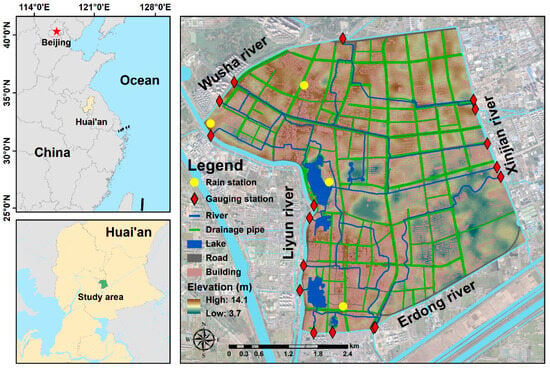
Figure 6.
The study area in Huai’an District.
3.2. Data Availability and Processing
Data were provided by the Huai’an Water Conservancy Bureau. Land use is classified into roads, buildings, and greenspaces, with area proportions of 11.7%, 16.3%, and 72.0%, respectively. The sewer network comprises over 4000 sewer segments and manholes, each with geographic, spatial, and geometric attributes. The river network consists of more than 200 river segments and over 700 cross-sections, along with 10 pumps and 36 sluices, for which detailed locations, design parameters, and operational regulations are available. The distribution of sluices and pumps is illustrated in Figure 7, and their operational rules are summarised in Table 1. The topographic data were derived from a high-resolution DEM (0.5 × 0.5 m). Field investigations were conducted to amend building and road footprints and to reconcile discrepancies among sewer, river, and DEM data. Manhole and river cross-section elevations were used to further correct the DEM.
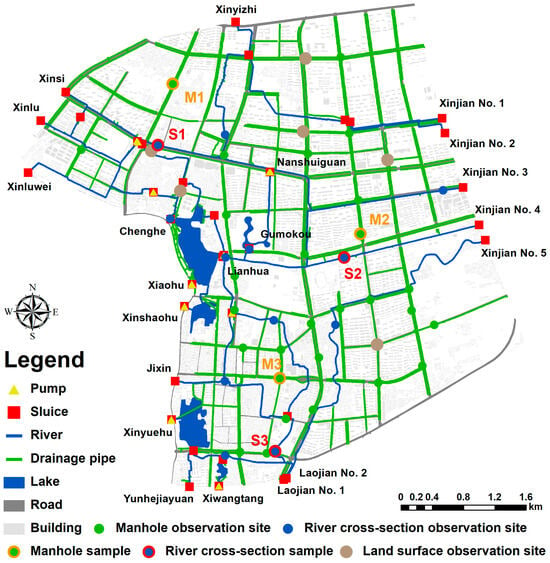
Figure 7.
Samples from manholes and river cross-sections, observation sites, sluices, and pumps.

Table 1.
Control rules for sluices and pumps.
Rainfall events from 22 July 2022 at 21:00 to 23 July 2022 at 15:00 and from 3 May 2023 at 06:00 to 4 May 2023 at 06:00, referred to as Event 1 and Event 2, respectively, were used to calibrate and validate the SFCM. The total rainfall depths were 35.4 mm (Event 1) and 38.5 mm (Event 2). These short-duration downpours were suitable for calibrating and validating the model. Rain gauge (Figure 6) data were recorded at 1 h intervals, water levels were measured using ultrasonic level sensors at 5 min intervals, and land surface inundation depths were observed by ultrasonic level sensors at 15 min intervals installed at key inundation sites near manholes or cross-sections (Figure 7). According to the Urban Flood Control and Drainage Master Plan of Huai’an City, the study area is designed for 20- and 100-year pluvial and fluvial protection standards, respectively. After calibration, the SFCM was used to simulate and analyse flooding under three extreme rainstorms representing 100-, 500-, and 1000-year return periods, with rainfall totals of 276.98, 334.11, and 358.73 mm, respectively, over 1440 min. The designed hyetographs are shown in Figure 8.
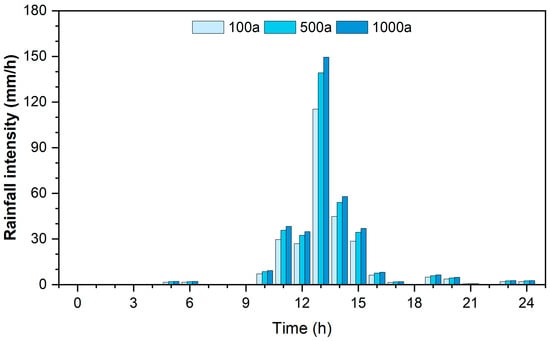
Figure 8.
Design rainstorm process.
3.3. Construction of SFCM and DEM-SPFITM
After subdividing the region into roads, rivers, and manhole locations, Thiessen polygons were created for 4331 subcatchments. Their attributes were assigned according to the corrected land use and topography data. Surface runoff was computed for each subcatchment using the Horton infiltration and non-linear reservoir methods. A total of 5098 nodes (including manholes, river cross-sections, and outfalls) and 5149 links (sewer segments and river segments) were connected to simulate 1D flows in the sewer network and rivers. The DEM was discretised into orthogonal cells for the overland flow domain (excluding buildings and river channels) using the orthogonal storage cell method to simulate surface flow.
Boundary conditions for the SFCM included four rainfall gages and 17 stations of water-level time series. Daily state of urban drainage system was used as the initial condition of SFCM. As the area is circumscribed by rivers and gates controlling hydraulic exchange, the model domain effectively captured the full flood process without losing water. The SFCM time step was set to 3 s. Given that the watershed is relatively independent and surrounded by river channels with gate control, the upstream and downstream water-level data provided favourable boundary conditions for simulating pluvial–fluvial flood processes within the district.
Using the DEM, the set of surface grid cells G was constructed, with each cell referencing a unique ground elevation. Based on initial conditions in the SFCM, the inundation status set S and inundation depth set D for each grid cell were created. During every time step, S and D were updated according to the logic indicated in Figure 4 and Figure 5, enabling DEM-SPFITM to track the flow pathways and volumetric exchanges for both pluvial and fluvial water in each cell.
4. Results
4.1. SFCM Calibration and Performance Evaluation
The SFCM was calibrated and validated with Events 1 and 2, respectively. Owing to limited field data, the calibration primarily focused on manhole heads, river cross-section heads, and inundation area/depth on the land surface. Key model parameters for SFCM included the Manning coefficient for overland flow, sewer and river channel flow, storage depression depths, and infiltration rates [27]. Parameter values were refined by comparing model simulations with observations. Table 2 presents the calibrated parameters.

Table 2.
SFCM calibration parameters.
From the observed dataset, three manholes (M1, M2, and M3) and three cross-sections (S1, S2, and S3) were randomly selected for comparison (Figure 7). Figure 9 contrasts simulated and observed hydraulic heads for three manholes (M1, M2, and M3) and three cross-sections (S1, S2, and S3) during Events 1 and 2. Figure 10 shows modelled inundation extents compared to observed inundation points, and Table 3 provides further detail.
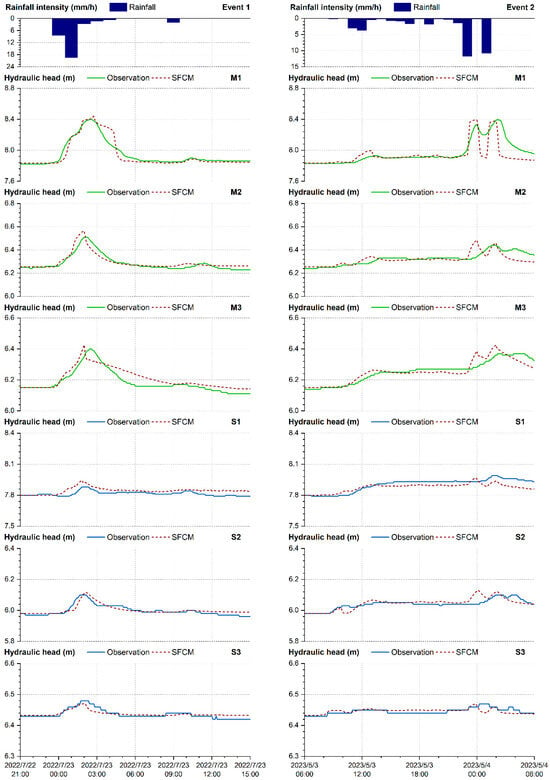
Figure 9.
Comparison of simulated vs. observed hydraulic heads in Events 1 and 2.
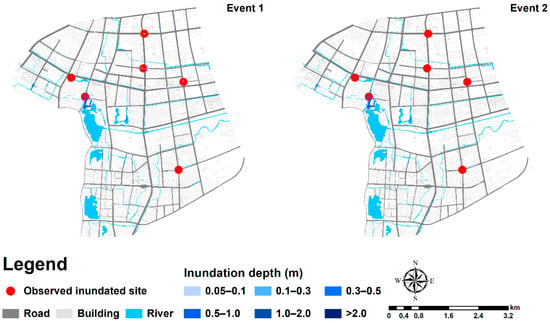
Figure 10.
Comparison of modelled and observed inundation sites in Events 1 and 2.

Table 3.
Detailed comparison between simulated and observed inundation depths in Events 1 and 2.
As shown in Figure 9, the observed hydraulic heads responded promptly to rainfall. Simulated and observed head variations were generally consistent, capturing key dynamics. Overall, simulated peak heads slightly exceeded observed peaks, with better performance observed in Event 1 than in Event 2, and better performance observed for river cross-section heads than manhole heads. Certain discrepancies were observed, such as earlier simulated peak timing and larger amplitude variations, mostly for manholes. To quantify these differences, the Nash–Sutcliffe efficiency (NSE) [28] was used:
where and are simulated and observed hydraulic heads at time t, and μo is the mean observed head. The average NSE across the six samples exceeded 0.77 in Event 1 and 0.68 in Event 2.
As shown in Figure 10, the simulated inundation areas for Events 1 and 2 overlapped. All observed inundation sites were within the simulated flooded area, and the model also identified additional flooded locations. According to Table 3, the maximum observed inundation depths at the monitoring sites tended to be higher than the simulated depths. Model performance was better in Event 1 than in Event 2, and some sites exhibited substantial deviations between simulated and observed maximum depths, typically with the model underestimating the inundation depth. The relative error (RE) was introduced to quantify model performance in simulating overland flooding:
Across all observed sites, the average RE for maximum simulated inundation depth was <23.2% in Event 1 and <57.29% in Event 2.
4.2. Evaluation of the Computational Efficiency of PFII
The SFCM, after verification, was employed to separately simulate the pluvial and fluvial flood processes for three storms, referred to as Method 1. In Method 2, the SFCM was used to jointly simulate both pluvial and fluvial flooding, while Method 3 employed the PFII to simulate the combined pluvial–fluvial flood process. Figure 11 illustrates a comparison of the computational efficiency of these methods.
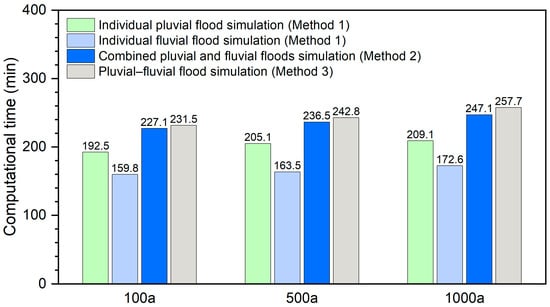
Figure 11.
Computational efficiency of the three methods.
For the three storms, the computation times for Method 1, which separately simulates pluvial and fluvial floods, were 192.5 min and 159.8 min, 205.1 min and 163.5 min, and 209.1 min and 172.6 min (Figure 11). For Method 2, the joint simulation of pluvial and fluvial floods resulted in computation times of 227.1 min, 236.5 min, and 247.1 min. In Method 3, the combined pluvial–fluvial flood simulation took 231.5 min, 242.8 min, and 257.7 min, respectively. As the rainfall intensity of the storms increased, the computation times for all methods also increased.
4.3. Joint Response of Surface Inundation to Pluvial and Fluvial Flooding
Using the calibrated SFCM and DEM-SPFITM, three extreme design storms (100-, 500-, and 1000-year) were simulated. From the outputs—cell inundation status set S and inundation depth set D—the peak flood scenario was extracted to derive the spatial distribution of inundation extent, depth composition, and velocity. Figure 12 presents the inundation distributions for the three extreme storms, and Figure 13 presents close-ups of selected regions.
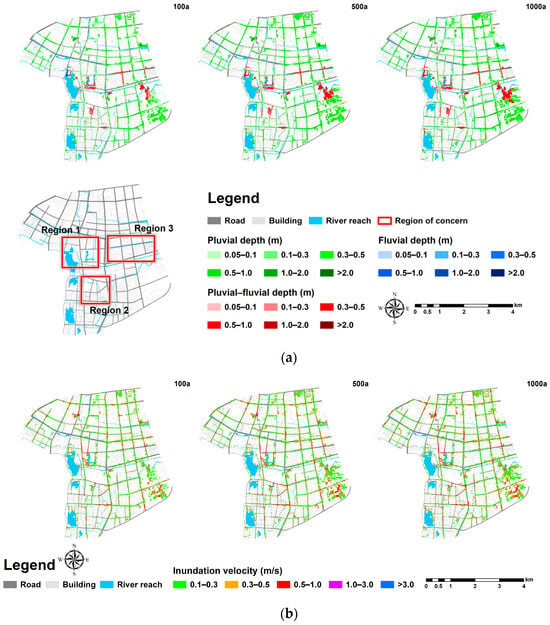
Figure 12.
Land surface inundation due to pluvial, fluvial, and pluvial–fluvial flooding. (a) Inundation extent and depth. (b) Inundation velocity.
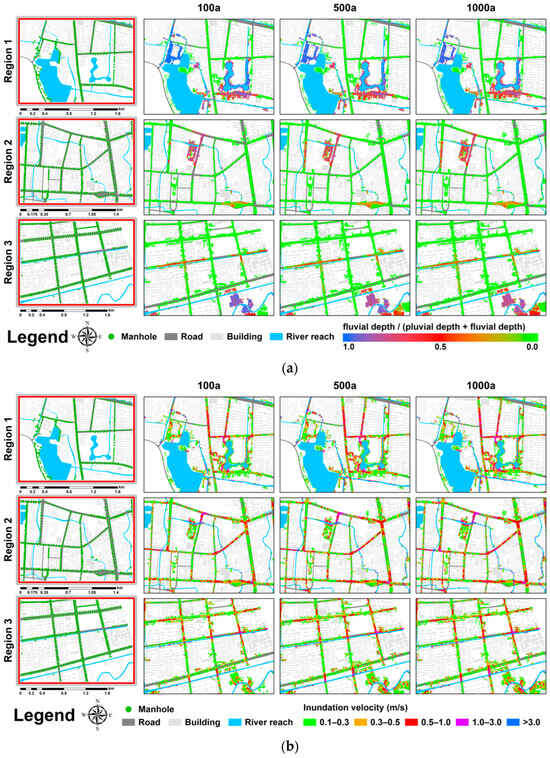
Figure 13.
Local-scale distributions of pluvial, fluvial, and pluvial–fluvial flooding. (a) Ratios of inundation depths. (b) Inundation velocity.
Pluvial flood extents were mostly concentrated on roads and adjacent areas with relatively shallow depth and low velocity (Figure 12). Some pluvial flooding occurred in farmland or other low-lying areas, with deeper inundation and relatively low velocity. Fluvial flooding predominantly occurred near river channels, with higher inundation depth and velocity. Pluvial–fluvial flooding mainly occurred at the intersections of roads and river networks, producing relatively high depths and velocities. As rainfall intensity and cumulative rainfall increased, pure fluvial flooding areas decreased, while pluvial–fluvial flooding increased and often occurred in high-depth, high-velocity zones.
In Regions 1, 2, and 3 under all three storm events, pluvial–fluvial flooding depths were predominantly 0.1–1.0 m, with fluvial water accounting for 60–100% of total inundation depth and velocities mainly between 0.5 and 1.0 m/s (Figure 13). Mixed pluvial–fluvial flooding was obvious, with fluvial water dominating depth in these areas.
In Figure 13, for Regions 1, 2, and 3 under all three storms, depths of pluvial–fluvial flooding are mostly between 0.1 and 1.0 m, with fluvial water accounting for 60–100% of total inundation depth, and velocities mainly between 0.5 and 1.0 m/s. Mixed pluvial–fluvial flooding is clearly visible, with fluvial water dominating depth in these areas.
4.4. Correlations Between Inundation Extent, Depth, and Velocity
4.4.1. Responses of Inundation Extent to Depth and Velocity
Under the 100-year storm, pluvial, fluvial, and pluvial–fluvial flooded areas were 281.39, 4.08, and 38.90 ha, respectively, corresponding to 86.75, 1.26, and 11.99%, respectively, of the total inundated area (Figure 14). Their mean inundation depths were 0.38 m (pluvial), 0.70 m (fluvial), and 0.45 m (pluvial–fluvial). Under the 500-year storm, the flooded areas were 326.84 ha (pluvial), 0.86 ha (fluvial), and 52.40 ha (pluvial–fluvial)—that is, 85.98%, 0.23%, and 13.79%, respectively—and their mean depths were 0.42, 0.41, and 0.55 m, respectively. Under the 1000-year storm, the pluvial, fluvial, and pluvial–fluvial flooded areas were 339.62 ha (85.26%), 0.88 ha (0.22%), and 57.83 ha (14.52%), respectively, and maximum depths were 0.44, 0.42, and 0.60 m, respectively. As rainfall intensity and cumulative depth increased, pluvial and pluvial–fluvial inundation areas and mean inundation depths gradually increased, with a decreasing rate of increase. However, pure fluvial inundation areas gradually decreased at a decreasing rate. The mean fluvial inundation depth first decreased and then increased.
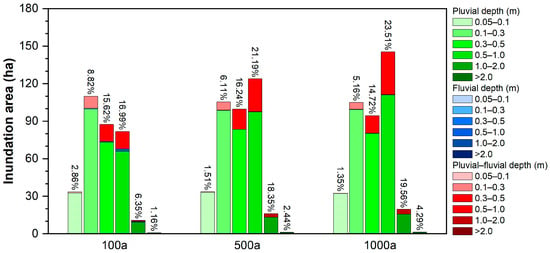
Figure 14.
Statistical analysis of inundation extent and depths under pluvial, fluvial, and pluvial–fluvial flooding.
In all three storm events, most surface flow velocities ranged from 0.1 to 1.0 m/s, where pluvial flooding dominated (Figure 15). For velocities exceeding 1.0 m/s, the shares of fluvial or pluvial–fluvial flooding increased significantly. The average inundation velocities of pluvial, fluvial, and pluvial–fluvial flooding under the 100-year storm were 0.32, 0.80, and 0.55 m/s, respectively; under the 500-year storm were 0.34 m/s, 1.86 m/s, and 0.61 m/s, respectively; and under the 1000-year storm were 0.36, 1.84, and 0.63 m/s, respectively. As rainfall intensity and volume increased, the average velocities of pluvial and pluvial–fluvial flooding increased steadily but at a decreasing rate, whereas fluvial velocities initially increased and then decreased.
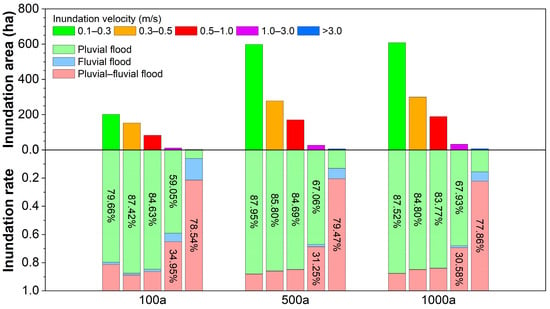
Figure 15.
Statistical analysis of inundation extent and velocity under pluvial, fluvial, and pluvial–fluvial flooding.
4.4.2. Influence of Inundation Depth on Flow Velocity
In all three storms (Figure 16), inundation depth exhibited the smallest effect on flow velocity in pluvial-flooded zones, mostly exhibiting low velocities. Pluvial–fluvial depth exerted the strongest effect on velocity, whereas fluvial flooding primarily occupied higher-velocity zones. With increasing rainfall intensity and volume, the impact of depth on velocity in pluvial and pluvial–fluvial zones weakened and decreased at a diminishing rate, while in fluvial zones it initially decreased and then rebounded.
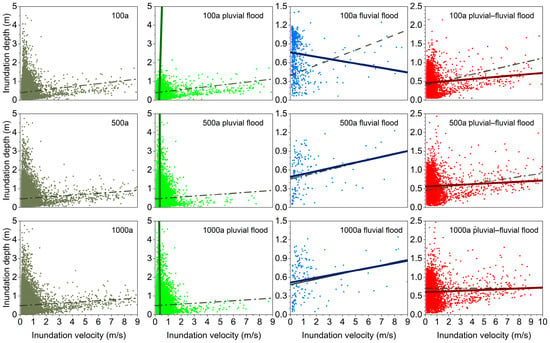
Figure 16.
Statistical analysis of inundation depth and velocity under pluvial, fluvial, and pluvial–fluvial flooding.
5. Discussion
Previous research has demonstrated that flood models are effective for identifying urban surface inundation under intense rainfall, and models based on hydrological and hydrodynamic methods are feasible for urban flood risk assessment [12,13,14]. This study extended this perspective by highlighting the simultaneous occurrence of pluvial and fluvial flooding in cities with extensive river networks. Our novel PFII framework comprised two core components: the SFCM and DEM-SPFITM. The SFCM provided integrated simulation of the complete set of processes in urban flooding, while DEM-SPFITM accounted for the formation and transformation of pluvial and fluvial floods by classifying and updating grid cells through a unified procedure that enhanced computational efficiency. This approach was adaptable to different spatial scales. At each time step, pluvial–fluvial flow pathways and volumetric exchanges were tracked and stored in the inundation status set S and the inundation depth set D. These outputs facilitated convenient data management, effectively identifying pluvial–fluvial flooding in the Huai’an District and offering a novel integrated flood management method.
Compared with prior urban flood studies that do not differentiate pluvial–fluvial interactions, the proposed methodology in this study accurately recognised individual pluvial and fluvial flood extents under three extreme rainstorms and examined the interaction between inundation extent, depth, and velocity. This yielded valuable insights for developing integrated urban flood control systems. As described in Section 4.2, compared to Approach 2, Approach 1, which simulates pluvial and fluvial floods separately, results in shorter computation times for each individual simulation. However, the total simulation time for both simulations is longer (Figure 11). While simulating both pluvial and fluvial floods simultaneously may improve computational efficiency, the data processing involved in overlaying pluvial–fluvial flood calculations remains complex. Compared to Approach 2, the average computation time for PFII increases by 2.96% (Figure 11), demonstrating a higher level of computational efficiency. As discussed in Section 4.3, pluvial flooding drove large-scale inundation; however, fluvial flooding further aggravated inundation, making their coexistence apparent and generally dominated by fluvial depth (Figure 12 and Figure 13). With increasing rainfall intensity and volume, pure fluvial flood areas contracted, whereas pluvial–fluvial flooding intensified (Figure 14). The mixed pluvial–fluvial regions frequently exhibited relatively high inundation depths and velocities (Figure 15), posing a severe threat to residential areas, agriculture, and critical infrastructure [29], and thus requiring attention in flood management. As demonstrated in Section 4.4, pluvial inundation generated the smallest average depth and velocity, with minimal depth–velocity interaction, while fluvial flooding exhibited a moderate average depth but the highest velocity and a significant depth–velocity correlation. Pluvial–fluvial flooding yielded the highest average depth, intermediate velocity, and the greatest depth–velocity interaction (Figure 15 and Figure 16). With increasing rainfall intensity and volume, pluvial and pluvial–fluvial inundation extents, depths, and velocities increased at a decreasing rate, likely due to the limited capacity of the urban drainage system. Meanwhile, fluvial inundation areas decreased, and their average depth and velocity changed in opposite directions, likely caused by rising river levels and backflow into the sewer network. These findings underscored the heightened complexity that pluvial–fluvial interactions introduce to urban flood management [30]. Mitigating pluvial flooding requires enhancements to sewer systems, sponge city infrastructure, and underground water storage. Controlling fluvial and mixed flooding similarly relies on improving river networks, reservoirs, lakes, and large-scale water projects, notably through joint river network operations that can reduce water levels before and during storms, thus mitigating flood risks.
Although PFII was applicable in this case study, uncertainties remain. As noted in Section 4.1, the SFCM was susceptible to uncertainties in data quality, process coupling, and simplifying assumptions. For example, the model may overestimate drainage capacity if it assumes sewers and rivers are free from sediment blockages. Despite these limitations, the simulated results for Events 1 and 2 generated acceptable errors, and the SFCM was appropriate for tracking pluvial–fluvial interactions under intense rainfall. Nonetheless, careful consideration is required in regions with different hydrologic and hydraulic conditions, ensuring that DEM-SPFITM inputs are feasible and, if necessary, selecting or adapting alternative flood modelling approaches. Moreover, DEM-SPFITM did not explicitly address cells simultaneously adjacent to both a manhole and a river cross-section; in this research, a small number of manholes or cross-sections were repositioned to minimise direct overlap. Finally, while this study concentrated on design storm events, broader scenarios under future climate variations should be explored. Future work should examine the suitability of PFII in diverse geographical contexts and under a wider range of scenarios.
6. Conclusions
This study introduced PFII, which incorporated the formation and mutual transformation of pluvial and fluvial floods via a DEM-based surface pluvial and fluvial inundation tracking model (DEM-SPFITM), integrated with a SFCM. The method traced the flow pathways and volumetric exchanges of pluvial and fluvial water, separately identifying their inundation extents, depths, and velocities under extreme rainstorms. Furthermore, it explored the interactions between these two flooding processes, effectively addressing the limitations in computational accuracy and efficiency associated with the conventional approach, which independently simulated pluvial and fluvial inundation before overlaying the results to estimate pluvial–fluvial flooding. The main conclusions were as follows:
- (1)
- PFII was successfully applied in Huai’an District, Huai’an City. Under the observed storm events, the SFCM produced 1D (sewer and river) water-level predictions with an average Nash–Sutcliffe efficiency > 0.82, and the maximum inundation depths in 2D overland flow exhibited average relative errors < 23.29%. DEM-SPFITM then independently identified pluvial and fluvial floods in three extreme rainstorm scenarios.
- (2)
- Pluvial flooding was the principal driver of widespread surface inundation, characterised by shallow depths, low velocities, and a limited impact of depth on velocity. Fluvial flooding further intensified surface inundation, rendering the mixed pluvial–fluvial phenomenon conspicuous.
- (3)
- In areas where pluvial and fluvial flooding co-occurred, fluvial depth often predominated, yielding higher overall inundation depths and a stronger effect of depth on velocity than those under purely pluvial or fluvial conditions.
- (4)
- As rainfall intensity and volume increased, fluvial flooding areas markedly decreased; however, pluvial–fluvial flooding intensified and concentrated in zones with greater inundation depth and velocity.
This study provided a novel approach to distinguishing between pluvial and fluvial flooding in urban environments, addressing key challenges in pluvial–fluvial flood analysis. Its applicability under extreme rainfall scenarios highlights its potential as a decision-support tool for urban flood management. These findings provide valuable insights for optimising drainage system planning, enhancing flood mitigation strategies, and refining risk zoning to support resilient and adaptive urban water resource management.
Author Contributions
Conceptualisation, Y.L. and W.L.; Methodology, Y.L. and W.L.; Software, Y.L. and H.W.; Validation, Y.L. and H.W.; Formal analysis, Y.L.; Investigation, Y.L.; Resources, Y.L. and H.W.; Data Curation, Y.L.; Writing—Original Draft Preparation, Y.L.; Writing—Review and Editing, Y.L.; Visualisation, Y.L.; Supervision, Y.L.; Project Administration, H.W.; Funding Acquisition, Y.L. and W.L. All authors have read and agreed to the published version of the manuscript.
Funding
This study was supported by the National Key Research and Development Program of China (2022YFC3800102), the National Natural Science Foundation of China (52179027), and the Major Science and Technology Projects of the Ministry of Water Resources of China (SKS-2022014).
Data Availability Statement
Rainfall and observed data used in this research is available online (https://120.36.9.138:8050/upms/#/guide, accessed on 27 March 2025) upon request of an account. Models are the property of the relevant parties; an early version is published on HydroShare (https://www.hydroshare.org/resource/22bafa74ee264f68b83e49cb078f79d1, accessed on 27 March 2025), and the full version can be made available to readers with the specific consent from those parties involved.
Acknowledgments
The authors sincerely thank all those who contributed their knowledge and experience to this study. We are particularly grateful to the Huai’an Water Resources Bureau for providing basic information and data.
Conflicts of Interest
The authors declare no conflicts of interest.
References
- Hallegatte, S.; Green, C.; Nicholls, R.J.; Corfee-Morlot, J. Future Flood Losses in Major Coastal Cities. Nat. Clim. Change 2013, 3, 802–806. [Google Scholar] [CrossRef]
- Zhu, W.; Cao, Z.; Luo, P.; Tang, Z.; Zhang, Y.; Hu, M.; He, B. Urban Flood-Related Remote Sensing: Research Trends, Gaps and Opportunities. Remote. Sens. 2022, 14, 5505. [Google Scholar] [CrossRef]
- Rentschler, J.; Avner, P.; Marconcini, M.; Su, R.; Strano, E.; Vousdoukas, M.; Hallegatte, S. Global Evidence of Rapid Urban Growth in Flood Zones since 1985. Nature 2023, 622, 87–92. [Google Scholar] [CrossRef]
- Láng-Ritter, J.; Berenguer, M.; Dottori, F.; Kalas, M.; Sempere-Torres, D. Compound Flood Impact Forecasting: Integrating Fluvial and Flash Flood Impact Assessments into a Unified System. Hydrol. Earth Syst. Sci. 2022, 26, 689–709. [Google Scholar] [CrossRef]
- Bates, P.D.; Quinn, N.; Sampson, C.; Smith, A.; Wing, O.; Sosa, J.; Savage, J.; Olcese, G.; Neal, J.; Schumann, G.; et al. Combined Modeling of US Fluvial, Pluvial, and Coastal Flood Hazard Under Current and Future Climates. Water Resour. Res. 2021, 57, e2020WR028673. [Google Scholar] [CrossRef]
- Guan, X.; Vorogushyn, S.; Apel, H.; Merz, B. Assessing Compound Pluvial-Fluvial Flooding: Research Status and Ways Forward. Water Secur. 2023, 19, 100136. [Google Scholar] [CrossRef]
- Apel, H.; Martínez Trepat, O.; Hung, N.N.; Chinh, D.T.; Merz, B.; Dung, N.V. Combined Fluvial and Pluvial Urban Flood Hazard Analysis: Concept Development and Application to Can Tho City, Mekong Delta, Vietnam. Nat. Hazards Earth Syst. Sci. 2016, 16, 941–961. [Google Scholar] [CrossRef]
- Han, L.; Cao, L.; Wu, Q.; Huang, J.; Yu, B. Identification of Surface Deformation-Sensitive Features under Extreme Rainfall Conditions in Zhengzhou City Based on Multi-Source Remote Sensing Data. Appl. Sci. 2023, 13, 13063. [Google Scholar] [CrossRef]
- Tull, N.; Passalacqua, P.; Hassenruck-Gudipati, H.J.; Rahman, S.; Wright, K.; Hariharan, J.; Mohrig, D. Bidirectional River-Floodplain Connectivity During Combined Pluvial-Fluvial Events. Water Resour. Res. 2022, 58, e2021WR030492. [Google Scholar] [CrossRef]
- Gosset, M.; Dibi-Anoh, P.A.; Schumann, G.; Hostache, R.; Paris, A.; Zahiri, E.-P.; Kacou, M.; Gal, L. Hydrometeorological Extreme Events in Africa: The Role of Satellite Observations for Monitoring Pluvial and Fluvial Flood Risk. Surv. Geophys. 2023, 44, 197–223. [Google Scholar] [CrossRef]
- Allen, G.I.; Gan, L.; Zheng, L. Interpretable Machine Learning for Discovery: Statistical Challenges and Opportunities. Annu. Rev. Stat. Appl. 2024, 11, 97–121. [Google Scholar] [CrossRef]
- Luo, P.; Luo, M.; Li, F.; Qi, X.; Huo, A.; Wang, Z.; He, B.; Takara, K.; Nover, D.; Wang, Y. Urban Flood Numerical Simulation: Research, Methods and Future Perspectives. Environ. Model. Amp; Softw. 2022, 156, 105478. [Google Scholar] [CrossRef]
- Li, D.; Marshall, L.; Liang, Z.; Sharma, A.; Zhou, Y. Bayesian LSTM with Stochastic Variational Inference for Estimating Model Uncertainty in Process-Based Hydrological Models. Water Resour. Res. 2021, 57, e2021WR029772. [Google Scholar] [CrossRef]
- Mignot, E.; Dewals, B. Hydraulic Modelling of Inland Urban Flooding: Recent Advances. J. Hydrol. 2022, 609, 127763. [Google Scholar] [CrossRef]
- Casulli, V. Semi-Implicit Finite Difference Methods for the Two-Dimensional Shallow Water Equations. J. Comput. Phys. 1990, 86, 56–74. [Google Scholar] [CrossRef]
- Casulli, V.; Cheng, R.T. Semi-implicit Finite Difference Methods for Three-dimensional Shallow Water Flow. Numer. Methods Fluids 1992, 15, 629–648. [Google Scholar] [CrossRef]
- Alcrudo, F.; Garcia-Navarro, P. A High-resolution Godunov-type Scheme in Finite Volumes for the 2D Shallow-water Equations. Int. J. Numer. Meth. Fluids 1993, 16, 489–505. [Google Scholar] [CrossRef]
- Bates, P.D.; Horritt, M.S.; Fewtrell, T.J. A Simple Inertial Formulation of the Shallow Water Equations for Efficient Two-Dimensional Flood Inundation Modelling. J. Hydrol. 2010, 387, 33–45. [Google Scholar] [CrossRef]
- Moghim, S.; Gharehtoragh, M.A.; Safaie, A. Performance of the Flood Models in Different Topographies. J. Hydrol. 2023, 620, 129446. [Google Scholar] [CrossRef]
- Kundzewicz, Z.W.; Pińskwar, I. Are Pluvial and Fluvial Floods on the Rise? Water 2022, 14, 2612. [Google Scholar] [CrossRef]
- Huang, S.; Wang, H.; Xu, Y.; She, J.; Huang, J. Key Disaster-Causing Factors Chains on Urban Flood Risk Based on Bayesian Network. Land 2021, 10, 210. [Google Scholar] [CrossRef]
- Merz, B.; Blöschl, G.; Vorogushyn, S.; Dottori, F.; Aerts, J.C.J.H.; Bates, P.; Bertola, M.; Kemter, M.; Kreibich, H.; Lall, U.; et al. Causes, Impacts and Patterns of Disastrous River Floods. Nat. Rev. Earth Environ. 2021, 2, 592–609. [Google Scholar] [CrossRef]
- Delleur, J.W.; Dendrou, S.A.; McPherson, M.B. Modeling the Runoff Process in Urban Areas. CRC Crit. Rev. Environ. Control. 1980, 10, 1–64. [Google Scholar] [CrossRef]
- Seyedashraf, O.; Bottacin-Busolin, A.; Harou, J.J. Many-Objective Optimization of Sustainable Drainage Systems in Urban Areas with Different Surface Slopes. Water Resour. Manage. 2021, 35, 2449–2464. [Google Scholar] [CrossRef]
- Li, G.; Zhao, H.; Liu, C.; Wang, J.; Yang, F. City Flood Disaster Scenario Simulation Based on 1D–2D Coupled Rain–Flood Model. Water 2022, 14, 3548. [Google Scholar] [CrossRef]
- Li, Y.; Badu Osei, F.; Hu, T.; Shi, Y.; Stein, A. Urban Inundation Mapping by Coupling 1D − 2D Models and Model Comparison. Int. J. Appl. Earth Obs. Geoinf. 2024, 130, 103869. [Google Scholar] [CrossRef]
- Zakizadeh, F.; Moghaddam Nia, A.; Salajegheh, A.; Sañudo-Fontaneda, L.A.; Alamdari, N. Efficient Urban Runoff Quantity and Quality Modelling Using SWMM Model and Field Data in an Urban Watershed of Tehran Metropolis. Sustainability 2022, 14, 1086. [Google Scholar] [CrossRef]
- Nash, J.E.; Sutcliffe, J.V. River Flow Forecasting through Conceptual Models Part I—A Discussion of Principles. J. Hydrol. 1970, 10, 282–290. [Google Scholar] [CrossRef]
- Cea, L.; Costabile, P. Flood Risk in Urban Areas: Modelling, Management and Adaptation to Climate Change. A Review. Hydrology 2022, 9, 50. [Google Scholar] [CrossRef]
- Muthusamy, M.; Rivas Casado, M.; Salmoral, G.; Irvine, T.; Leinster, P. A Remote Sensing Based Integrated Approach to Quantify the Impact of Fluvial and Pluvial Flooding in an Urban Catchment. Remote Sens. 2019, 11, 577. [Google Scholar] [CrossRef]
Disclaimer/Publisher’s Note: The statements, opinions and data contained in all publications are solely those of the individual author(s) and contributor(s) and not of MDPI and/or the editor(s). MDPI and/or the editor(s) disclaim responsibility for any injury to people or property resulting from any ideas, methods, instructions or products referred to in the content. |
© 2025 by the authors. Licensee MDPI, Basel, Switzerland. This article is an open access article distributed under the terms and conditions of the Creative Commons Attribution (CC BY) license (https://creativecommons.org/licenses/by/4.0/).